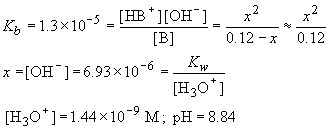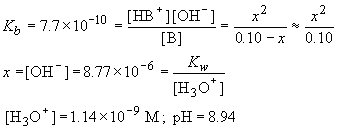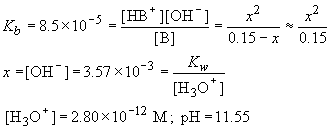
The solution is basic.
Chemistry Homework Assignment #4
Kotz & Treichel: Chapter 17
17) NH4+ (aq) + Br- (aq) + H2O (l) ® NH3 (aq) + Br- (aq) + H3O+ (aq)
In this reaction, bromide acts as a spectator ion, and ammonium donates
a proton to water to form hydronium.
23a) The strongest acid is the one with the largest acid ionization constant, Ka. In this case carbonic acid, H2CO3, is the strongest of the weak acids listed. Phenol, C6H5OH, is the weakest.
b) Since KaKb = Kw for any conjugate acid-base pair, there is an inverse relationship between the strength of an acid and the strength of its conjugate base. Thus, carbonic acid has the weakest conjugate base (its conjugate base has the smallest Kb).
c) By the same logic as "b", phenol will have the strongest conjugate
base.
25a) Using the same logic used above, we can say that cyanide, CN-, is the strongest weak base listed - it has the largest Kb. Nitrite, NO2-, is the weakest.
b) The conjugate acid of HS- is H2S.
c) Nitrite has the strongest conjugate acid. Cyanide has the weakest
conjugate acid.
31) When Bronsted-Lowry acids and bases react, the equilibrium lies on the side of the weaker conjugate acid and bases, that is, stronger acids and bases will react to form weaker acids and bases. Using the tables of relative acid and base strengths (Table 17.3), we can say the following:
a) The equilibrium in the reaction, H2S (aq) + CO32- (aq) « HS- (aq) + HCO3- (aq) , will lie to the right.
This equilibrium will lie to the left.
c) CN- (aq) + NH3 (aq) « HCN (aq) + NH2- (aq)
This equilibrium will lie to the left.
d) CH3CO2H (aq) + SO42- (aq) « CH3CO2- (aq) + HSO4- (aq)
This equilibrium will lie to the left.

The solution is basic.
The reaction is: CH3NH2 (aq) + H2O (l) « CH3NH3+ (aq) + OH- (aq)
| CH3NH2 (M) | CH3NH3+ (M) | OH- (M) | |
| Initial | 0.065 | 0 | 0 |
| D | -5.0 ´ 10-3 | 5.0 ´ 10-3 | 5.0 ´ 10-3 |
| Final | 0.060 | 5.0 ´ 10-3 | 5.0 ´ 10-3 |
The equilibrium expression is:

| HA (M) | A- (M) | H3O+ (M) | |
| Initial | 0.0274 | 0 | 0 |
| D | -x | x | x |
| Final | 0.0274-x | x | x |
Where HA is propanoic acid and A- is propionate. Thus,

Note that in this case, use of the above approximation may not be warranted,
since the value of x is greater than 5% of the initial acid concentration.
Using the quadratic equation, we would have obtained, x = 2.04 ´
10-4 and the pH would be 3.69.
| B (M) | HB+ (M) | OH- (M) | |
| Initial | 0.12 | 0 | 0 |
| D | -x | x | x |
| Final | 0.12-x | x | x |
Where B is aniline and HB+ is anilinium. Thus,

b) NaC6H5CO2: this will give a basic solution since it is the salt of a strong base (NaOH) and a weak acid (C6H5CO2H).
c) Na2HPO4: this will give a basic solution since it is the salt of a strong base (NaOH) and a weak acid (H2PO4-).
B + H2O « HB+ + OH-. We can solve this problem in the usual way for a weak base.
| B (M) | HB+ (M) | OH- (M) | |
| Initial | 0.10 | 0 | 0 |
| D | -x | x | x |
| Final | 0.10-x | x | x |

| B (M) | HB+ (M) | OH- (M) | |
| Initial | 0.0015 | 0 | 0 |
| D | -x | x | x |
| Final | 0.0015-x | x | x |

Note that in this case, use of the above approximation may not be warranted,
since the value of x is greater than 5% of the initial base concentration.
Using the quadratic equation, we would have obtained, x = 1.00 ´
10-4 and the pH would be 10.00.
HB+ + H2O « H2B2+ + OH- Kb2
For ethylenediamine, a most foul-smelling beasty, the Kb values are: Kb1 = 8.5 ´ 10-5, and Kb2 = 2.7 ´ 10-8.
Since Kb2 is so much smaller than Kb1,
we can simplify the problem by realizing that almost all of the hydroxide
present in solution is due to the first ionization process. We can then
treat this as a monoprotic base with an equilibrium constant equal to Kb1.
| B (M) | HB+ (M) | OH- (M) | |
| Initial | 0.15 | 0 | 0 |
| D | -x | x | x |
| Final | 0.15-x | x | x |

To calculate the concentration of the fully protonated form, H2B2+,
we use the second basic equilibrium reaction above and do the following:
| HB+ (M) | H2B2+ (M) | OH- (M) | |
| Initial | 3.57 ´ 10-3 | ~ 0 | 3.57 ´ 10-3 |
| D | -x | x | x |
| Final | 3.57 ´ 10-3 - x | x | 3.57 ´ 10-3 + x |

79) The oxide ion has four lone pairs of electrons. It can act as a
Lewis base and donate one pair to form a bond to the carbon in CO2
(the Lewis acid) to form a coordinate covalent bond. Note that in this
case, since the carbon already has a full octet, it must "give up" one
of the electron pairs in a double bond so as not to violate the octet rule.
Thus, the carbonate ion has a formal Lewis structure having two single
bonds and one double bond.
99) The concentration of the acid is 0.135 M. Since the final pH is 2.70, the equilibrium value of [H3O+] is 3.00 ´ 10-3 M. Thus we can set up the concentration table as follows.
| HA (M) | A- (M) | H3O+ (M) | |
| Initial | 0.135 | 0 | 0 |
| D | -3.0 ´ 10-3 | 3.0 ´ 10-3 | 3.0 ´ 10-3 |
| Final | 0.135-3.0 ´ 10-3 | 3.0 ´ 10-3 | 3.0 ´ 10-3 |
Therefore,
![]()

c) Using the result provided in step b, the pH is found by:
